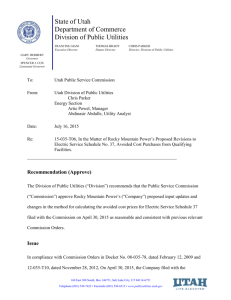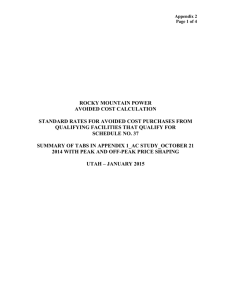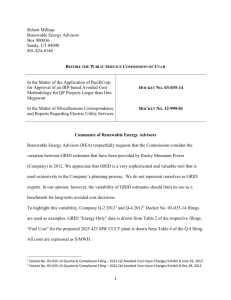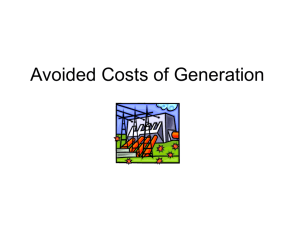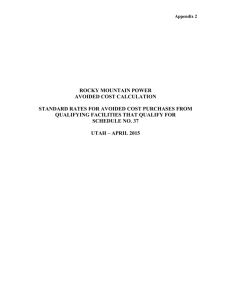Direct Testimony of Brian S. Dickman
advertisement
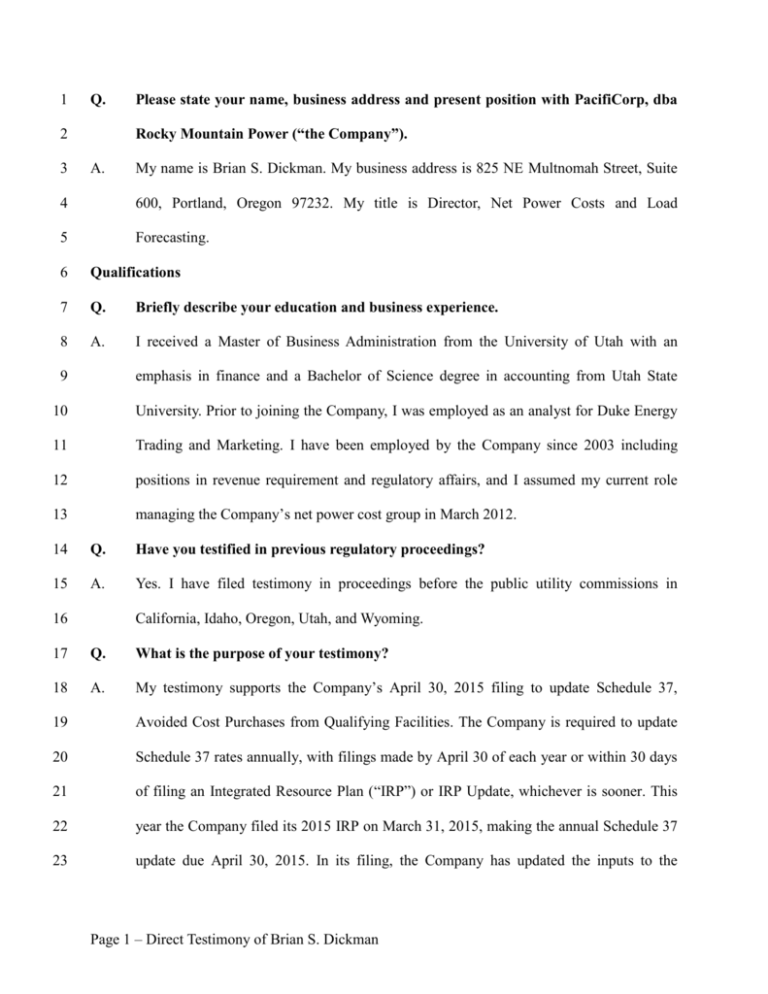
1 Q. Rocky Mountain Power (“the Company”). 2 3 Please state your name, business address and present position with PacifiCorp, dba A. My name is Brian S. Dickman. My business address is 825 NE Multnomah Street, Suite 4 600, Portland, Oregon 97232. My title is Director, Net Power Costs and Load 5 Forecasting. 6 Qualifications 7 Q. Briefly describe your education and business experience. 8 A. I received a Master of Business Administration from the University of Utah with an 9 emphasis in finance and a Bachelor of Science degree in accounting from Utah State 10 University. Prior to joining the Company, I was employed as an analyst for Duke Energy 11 Trading and Marketing. I have been employed by the Company since 2003 including 12 positions in revenue requirement and regulatory affairs, and I assumed my current role 13 managing the Company’s net power cost group in March 2012. 14 Q. Have you testified in previous regulatory proceedings? 15 A. Yes. I have filed testimony in proceedings before the public utility commissions in California, Idaho, Oregon, Utah, and Wyoming. 16 17 Q. What is the purpose of your testimony? 18 A. My testimony supports the Company’s April 30, 2015 filing to update Schedule 37, 19 Avoided Cost Purchases from Qualifying Facilities. The Company is required to update 20 Schedule 37 rates annually, with filings made by April 30 of each year or within 30 days 21 of filing an Integrated Resource Plan (“IRP”) or IRP Update, whichever is sooner. This 22 year the Company filed its 2015 IRP on March 31, 2015, making the annual Schedule 37 23 update due April 30, 2015. In its filing, the Company has updated the inputs to the Page 1 – Direct Testimony of Brian S. Dickman 24 calculation of Schedule 37 rates and proposed one change to the way avoided costs are 25 calculated for Schedule 37. My testimony supports the change proposed by the Company. 26 Q. 27 28 Please describe the change to the calculation of Schedule 37 rates proposed by the Company in this filing. A. The Company proposes that avoided cost rates during the sufficiency period no longer 29 include capacity costs related to the deferral of a simple cycle combustion turbine 30 (“SCCT”). During the sufficiency period the Company has no plans to procure additional 31 thermal capacity resources. The 2015 IRP calls for the Company to utilize front office 32 transactions (“FOTs”), which represent short-term firm wholesale market purchases, to 33 meet its capacity needs. Rather than imputing capacity costs based on a fictitious SCCT, 34 avoided costs during the sufficiency period should be calculated using the GRID model 35 including the value of short-term firm market purchases that can be displaced by a 36 qualifying facility (“QF”). The sufficiency period prices calculated in GRID should also 37 be differentiated into on- and off-peak periods based on the relationship of Palo Verde on- 38 and off-peak market prices. The Company’s proposed change results in avoided cost 39 prices that best represent the costs that will actually be avoided during the sufficiency 40 period. As described later, the Company’s proposal eliminates an unnecessary difference 41 that remains between the calculation of avoided costs for small QFs under Schedule 37 42 and large QFs under Schedule 38. Details supporting the Company’s proposed avoided 43 costs were provided as appendices to its filing; specifically Appendix 1, Appendix 2, and 44 Confidential Appendix 3. Confidential Appendix 4 was also provided which includes the 45 calculation of avoided costs consistent with the Commission’s orders issued January 16, 46 2015, and February 13, 2015 in Docket Nos. 14-035-55 and 14-035-T04. Page 2 – Direct Testimony of Brian S. Dickman 47 Q. Has the Company proposed this change before? If so, how is this proposal different? 48 A. Yes. In its May 7, 2014, filing to update Schedule 37 the Company also proposed to 49 eliminate the SCCT fixed costs during the sufficiency period. However, in that filing, 50 when the costs of the SCCT were removed from the sufficiency period, the resulting 51 Schedule 37 prices were simply equal to the average avoided costs from the GRID 52 model, with no recognition of the value of QF energy during on- and off-peak periods. 53 The Commission cited this as the deciding factor leading to its conclusion to not adopt 54 the Company’s proposal: 55 56 57 58 59 60 61 “In PacifiCorp’s Schedule 37 proposed method, without any value for the SCCT, the rates for on-peak and off-peak energy are the same. Thus, the rates paid to a QF delivering all its energy on-peak will understate costs avoided and the rates paid to a QF delivering all its energy off-peak will overstate the costs avoided by the QF….[The] deciding factor for this issue is the fact that in the proposal in front of us, with the SCCT cost removed, the peak and offpeak prices are identical during the period of resource sufficiency.”1 62 In its Order issued October 21, 2014, the Commission directed the Company “ to 63 file a potential adjustment to the Schedule 37 method that produces distinct peak and off- 64 peak prices in the resource sufficiency period.”2 To remedy the issue identified by the 65 Commission, in this filing, the proposed Schedule 37 prices during the sufficiency period 66 have differentiated on- and off-peak prices based on the relationship of Palo Verde on- and 67 off-peak market prices relative to flat Palo Verde market prices. Later in my testimony I 68 show that the prior method of adding SCCT fixed costs to the GRID modeled avoided 69 costs overstates the prices that should be paid for energy and capacity during the 70 sufficiency period. Docket Nos. 14-035-55 and 14-035-T04, Order Partially Addressing Rocky Mountain Power’s Petition for Reconsideration, Review or Rehearing of the Commission’s December 30, 2014 Order on Review and Motion for Stay, January 29, 2015, page 7. 2 Docket Nos. 14-035-55 and 14-035-T04, Report and Order Issued October, 21, 2014 page 19. 1 Page 3 – Direct Testimony of Brian S. Dickman 71 Q. the sufficiency period? 72 73 What is the impact on avoided cost rates if the SCCT fixed costs are eliminated from A. Table 1 compares the current Schedule 37 rates to updated rates using the currently- 74 approved method (i.e., including the SCCT costs during the sufficiency period)3 and 75 updated rates based on GRID modeled results excluding the SCCT costs but with 76 differentiated on- and off-peak prices. Table 1 20 Year (2016 to 2035) Levelized Prices (Nominal) @ 6.66% Discount Rate ($/MWH) BASE LOAD WIND SOLAR FIXED SOLAR TRACKING Current Rates (Includes SCCT costs during sufficiency period) $54.33 $37.71 $54.27 $58.52 Updated Rates (Includes SCCT costs during sufficiency period) Proposed Rates (No SCCT costs, differentiated on/off-peak prices) Impact of Removing SCCT Costs $45.01 $32.75 $42.67 $45.94 $39.34 ($5.67) $32.08 ($0.68) $38.53 ($4.14) $40.26 ($5.68) 77 As shown in Table 1, if the fixed costs of a SCCT continue to be imputed in 78 Schedule 37 avoided costs during the sufficiency period, the Company’s retail customers 79 will pay prices for QFs that are higher than the avoided cost of energy and capacity from 80 other sources, contrary to the customer indifference standard in the Public Utility 81 Regulatory Policies Act of 1978 (“PURPA”). 82 Q. As background information, please describe the currently-approved method for 83 calculating avoided costs for small QFs qualifying for published rates under 84 Schedule 37. 85 A. The framework for the calculation of rates under Schedule 37 was first approved by the 86 Commission in Docket No. 94-2035-03. In its July 1995 order, the Commission approved 87 a combined differential revenue requirement and proxy method for determining avoided Capacity contribution of intermittent resources is based on the values originally approved by the Commission in Docket No. 12-035-100, and included in Docket No. 14-035-T04. 3 Page 4 – Direct Testimony of Brian S. Dickman 88 costs. Since that time various adjustments have been made to the calculation details, with 89 the most recent changes effective February 20, 2015. Published rates under Schedule 37 90 are available to cogeneration facilities up to 1 MW and other small power production 91 facilities, including wind and solar resources, up to 3 MW. 92 The determination of avoided costs is divided into two periods: resource 93 sufficiency and resource deficiency. During the sufficiency period, avoided costs are 94 calculated using GRID, the Company’s production cost model. Net power costs (“NPC”) 95 are calculated using two system dispatch simulations, one without any new QF resources 96 and one with an additional 10 MW QF resource included as a system resource at zero 97 cost. The period of resource deficiency begins coincident with the next deferrable 98 resource identified in the Company’s most recent IRP or IRP Update. During the 99 deficiency period avoided costs are equal to the fixed and variable costs of a proxy resource, currently a combined cycle combustion turbine (“CCCT”). 100 101 The current method also calls for additional capacity costs, based on the fixed 102 costs of a SCCT, to be added to the avoided costs produced by the GRID model during 103 the sufficiency period. As described above, the issue of whether it is appropriate to 104 include SCCT costs during the sufficiency period was raised in Docket Nos. 14-035-55 105 and 14-035-T04. In those dockets, the Commission declined to change the current 106 method but directed the Company to propose an alternative in its next Schedule 37 107 update. 108 Q. large QFs under Schedule 38? 109 110 Is the currently approved method for Schedule 37 used to calculate avoided costs for A. No. Avoided costs for large QFs are calculated using the Proxy/Partial Displacement Page 5 – Direct Testimony of Brian S. Dickman 111 Differential Revenue Requirement (“PDDRR”) method. The methods are similar in that 112 both utilize the GRID model to determine avoided costs during the sufficiency period and 113 both include capacity costs of a CCCT beginning with the next deferrable resource in the 114 Company’s IRP. The Proxy/PDDRR method, however, continues to use a combination of 115 the GRID model and partial displacement of a CCCT during the deficiency period rather 116 than basing avoided costs solely on the proxy CCCT. Furthermore, during the sufficiency 117 period the Proxy/PDDRR avoided costs include displacement of FOTs and do not include 118 additional capacity costs from a SCCT. The Commission recently affirmed this treatment 119 is appropriate in Docket No. 12-035-100 when it found: 120 121 122 123 124 125 126 127 “We are persuaded the Proxy/PDDRR method properly reflects avoided capacity costs associated with FOTs during the period of resource sufficiency. The evidence proffered by PacifiCorp and the Office shows a QF’s displacement of FOTs, as determined within the GRID model, results in what PacifiCorp would have otherwise paid for capacity purchases. Thus, the inclusion of additional capacity value when a FOT is displaced would over-compensate the QF and violate the ratepayer neutrality objective.”4 128 When the Commission approved new Schedule 37 rates in Docket Nos. 14-035- 129 55 and 14-035-T04 several changes were adopted that were designed to enhance 130 consistency with the Schedule 38 calculation, including: reflecting the integration costs 131 and capacity contribution of intermittent resources, excluding future CO2 taxes from the 132 official forward price curve, and eliminating separate payments to the QF for capacity 133 and energy. 134 Q. 135 136 Has the Commission previously addressed avoided capacity costs during the sufficiency period for Schedule 37? A. 4 Yes. In Docket Nos. 14-035-55 and 14-035-T04, the Commission initially approved the Docket No. 12-035-100, August 16, 2103 Order at 35. Page 6 – Direct Testimony of Brian S. Dickman 137 Company’s request to remove the SCCT costs from the sufficiency period, but later 138 reversed its decision until additional evidence could be presented. In its October 21, 2014 139 order the Commission stated: “Among other things, this order approves PacifiCorp’s proposal to eliminate the annual fixed costs of a SCCT during the period of resource sufficiency. This action is based, at least in part, on our Schedule 38 Order that finds wholesale power purchased to meet capacity constraints already contains capacity value; therefore, adding the SCCT value to the wholesale market price is excessive. We note, however, the peak and off-peak rates PacifiCorp proposes for Schedule 37 are equal during the resource sufficiency period (with the SCCT costs removed). In other words, the capacity value contained in the wholesale power purchase to meet peak hour constraints is averaged across all hours in the proposed rates…To examine the effects of this particular difference in the Schedule 37 and 38 methods, we direct PacifiCorp to file a potential adjustment to the Schedule 37 method that produces distinct peak and off-peak prices in the resource sufficiency period.”5 140 141 142 143 144 145 146 147 148 149 150 151 152 In its December 30, 2014, Order on Review the Commission stated: 153 154 155 156 157 158 159 160 161 162 163 164 165 “While it remains our goal to produce logically consistent avoided cost pricing in Schedule 37 and Schedule 38, we recognize the record in this case presents no alternative means, aside from the fractional SCCT value, for calculating the full Schedule 37 avoided capacity cost during resource constrained months in the period of resource sufficiency. Thus, pending receipt of additional evidence in a future proceeding, we will maintain the SCCT cost component in Schedule 37 to account for the value of capacity avoided in the constrained months during years in which PacifiCorp is otherwise resource sufficient. We await the presentation of evidence in future Schedule 37 proceedings describing any alternative approach for valuing avoided capacity costs and peak and off-peak avoided costs during the period of resource sufficiency.”6 166 The Company’s proposal in this case to eliminate the fixed costs of an SCCT from the 167 sufficiency period and to differentiate on-and off-peak prices paid to the QF is consistent 168 with the Commission’s past orders and is also consistent with the approach used for 169 Schedule 38. 5 6 Docket Nos. 14-035-55 and 14-035-T04, Report and Order Issued October, 21, 2014 page 18. Docket Nos. 14-035-55 and 14-035-T04, Order on Review, December 30, 2014, page 14. Page 7 – Direct Testimony of Brian S. Dickman 170 Q. 171 172 Is it appropriate to rely on the Company’s IRP in determination of Schedule 37 rates? A. Yes. The current method for calculating Schedule 37 rates is directly dependent upon the 173 Company’s IRP, including the demarcation of the resource deficiency period and the type 174 and cost of the deferrable resource. During the resource sufficiency period the IRP 175 identifies that the Company is avoiding FOTs, or short-term firm market purchases, and 176 therefore reflect avoided capacity costs. It makes no logical sense for the Company to pay 177 avoided costs based on an SCCT that it is not actually avoiding, or for it to build SCCTs 178 during the resource sufficiency period for QFs to avoid. 179 The Commission has consistently referred back to the Company’s IRP when 180 determining whether proposed avoided cost rates are appropriate. When the Commission 181 found in Docket No. 12-035-100 that additional capacity costs should not be added in the 182 sufficiency period for the Proxy/PDDRR method it concluded, “The evidence proffered 183 by the Company and the Office shows a QF’s displacement of FOTs, as determined 184 within the GRID model, results in what PacifiCorp would have otherwise paid for 185 capacity purchases.” 186 Q. 187 188 How did the Company calculate Schedule 37 avoided capacity costs during the sufficiency period in this filing? A. In this filing the Company calculated the sufficiency period avoided costs using the 189 GRID model, including the displacement of FOTs identified in the IRP. The avoidance of 190 short-term firm market purchases is readily identifiable in the GRID study results 191 provided as Confidential Appendix 3 to the workpapers supporting the Company’s filing. 192 In support of its proposal to eliminate imputation of SCCT fixed costs during the Page 8 – Direct Testimony of Brian S. Dickman 193 sufficiency period, the Company included in the GRID model calculation the FOTs 194 identified in the 2015 IRP, and reflected partial displacement of these FOTs when 195 calculating avoided costs. This partial displacement of FOTs in the GRID model is the 196 same as done for large QFs under the Proxy/PDDRR method. To reflect the value of 197 energy generated by a QF during on- and off-peak periods, the Company shaped the 198 avoided costs produced by the GRID model into distinct on- and off-peak prices based on 199 the relationship of Palo Verde on- and off-peak market prices to flat market prices at Palo 200 Verde each month. 201 Q. shape to the average avoided costs from the GRID model? 202 203 Why is it appropriate to shape avoided costs by applying the Palo Verde market A. Calculating the avoided costs using the GRID model, with on- and off peak prices 204 differentiated based on the shape of Palo Verde market prices, best aligns the avoided cost 205 prices with the costs that are actually avoided during the sufficiency period and 206 recognizes the difference in value of energy generated by a QF during on- and off-peak 207 periods. Table 2 illustrates the price differential resulting from the Company’s proposal 208 by comparing the flat avoided costs from GRID to the on- and off-peak prices proposed 209 in this filing for a base load QF. Page 9 – Direct Testimony of Brian S. Dickman Table 2 Year 2015 2016 2017 2018 2019 2020 2021 2022 2023 2024 2025 2026 2027 210 Q. 211 212 GRID Model Avoided Cost (a) Average $23.92 $23.97 $25.24 $27.47 $28.73 $29.34 $32.33 $34.95 $38.02 $39.02 $41.39 $42.80 $44.67 PV Shaped Avoided Costs (b) On-Peak $27.73 $27.50 $28.14 $30.92 $32.46 $32.92 $36.69 $39.96 $42.55 $44.57 $46.55 $47.94 $48.79 (c) Off-Peak $22.01 $22.12 $23.22 $24.82 $26.06 $26.33 $28.86 $31.31 $34.33 $34.67 $37.02 $38.70 $39.54 Differential (b) - (a) On-Peak $3.81 $3.53 $2.90 $3.45 $3.73 $3.58 $4.36 $5.01 $4.53 $5.55 $5.16 $5.14 $4.12 (c) - (a) Off-Peak ($1.91) ($1.85) ($2.02) ($2.65) ($2.67) ($3.01) ($3.47) ($3.64) ($3.69) ($4.35) ($4.37) ($4.10) ($5.13) Why is the Company’s proposed approach more accurate than including the fixed costs of a SCCT? A. Avoided cost prices during the sufficiency period must be consistent with the Company’s 213 resource procurement plans to avoid burdening retail customers with QF costs that are 214 higher than the costs actually avoided by the Company. Consistent with the customer 215 indifference standard under PURPA, the avoided costs modeled in GRID accurately 216 represent the energy and capacity costs that can be avoided during the sufficiency period, 217 including displacement of short-term firm market transactions. Imputing the fixed costs 218 of a fictitious SCCT the Company has no plans to build on top of the avoided costs from 219 GRID double counts avoided capacity costs because the average costs from GRID 220 already include avoided firm market transactions. Table 3 compares the average avoided 221 costs from GRID to the Company’s proposal and to the avoided costs that would result if 222 the Company’s proposed changes are rejected (i.e. SCCT costs are included in the Page 10 – Direct Testimony of Brian S. Dickman 223 sufficiency period).7 Note that the off-peak prices under the SCCT method are equal to 224 the average avoided costs from the GRID model. Table 3 Year 2015 2016 2017 2018 2019 2020 2021 2022 2023 2024 2025 2026 2027 GRID Model Avoided Cost (a) Average $23.92 $23.97 $25.24 $27.47 $28.73 $29.34 $32.33 $34.95 $38.02 $39.02 $41.39 $42.80 $44.67 PV Shaped Avoided Costs (b) On-Peak $27.73 $27.50 $28.14 $30.92 $32.46 $32.92 $36.69 $39.96 $42.55 $44.57 $46.55 $47.94 $48.79 (c) Off-Peak $22.01 $22.12 $23.22 $24.82 $26.06 $26.33 $28.86 $31.31 $34.33 $34.67 $37.02 $38.70 $39.54 Avoided Costs Including SCCT Costs (d) (e) On-Peak Off-Peak $34.77 $23.92 $35.08 $23.97 $38.46 $25.24 $39.05 $27.47 $40.55 $28.73 $43.42 $29.34 $46.71 $32.33 $51.73 $34.95 $55.17 $38.02 $56.53 $39.02 $63.76 $41.39 $63.35 $42.80 $65.66 $44.67 Difference Difference (d)-(b) On-Peak $7.04 $7.58 $10.32 $8.13 $8.09 $10.50 $10.02 $11.77 $12.62 $11.96 $17.21 $15.41 $16.87 (e)-(c) Off-Peak $1.91 $1.85 $2.02 $2.65 $2.67 $3.01 $3.47 $3.64 $3.69 $4.35 $4.37 $4.10 $5.13 225 The results in Table 3 demonstrate that adding the fixed costs of a SCCT over-states the 226 avoided capacity costs because it includes the avoided firm market transactions and costs 227 of a resource the Company can’t actually avoid. 228 Q. Does this conclude your direct testimony? 229 A. Yes. 7 Work papers used for the calculation of avoided costs rates which includes SCCT costs are provided as Confidential Appendix 4 to the Company’s filing. Page 11 – Direct Testimony of Brian S. Dickman
